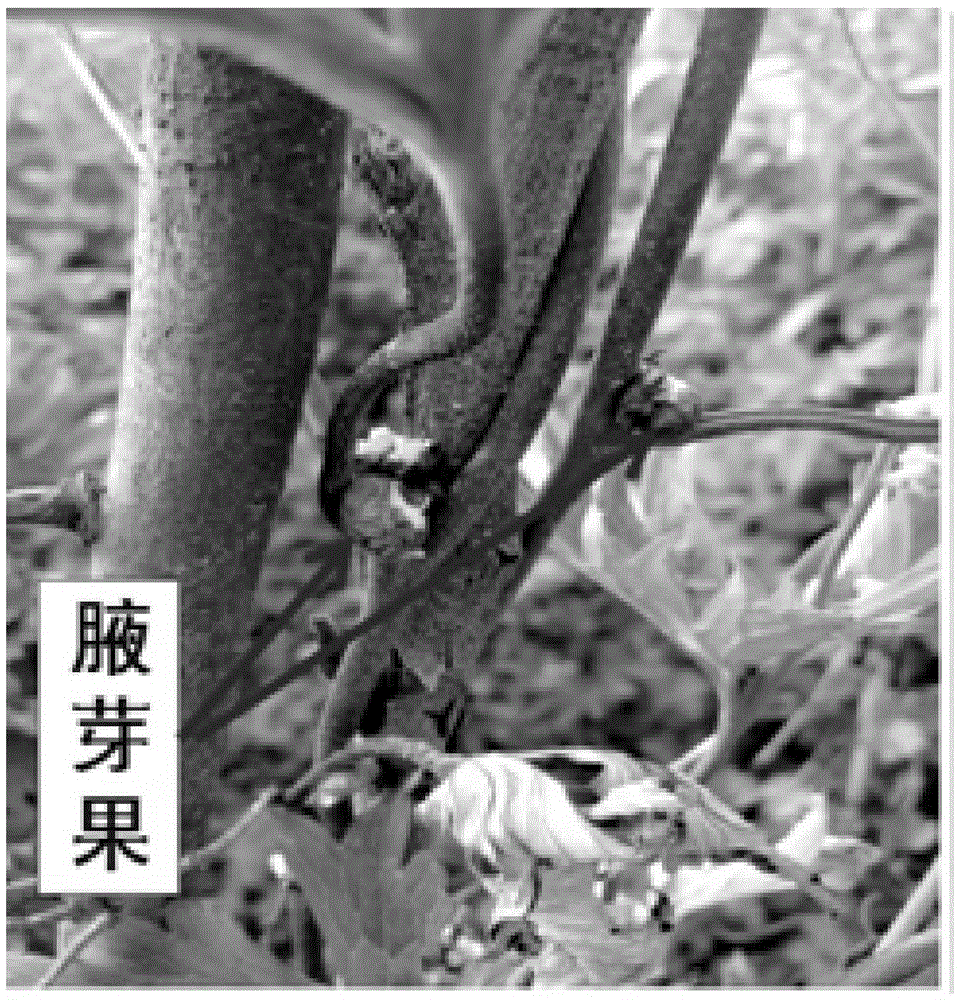Bulbil propagation technology for aconitum vilmorimianum Kom.
A technology of pearl buds and yellow grass, applied in the field of the cultivation of yellow grass, can solve the problems of easy disease, difficult preservation, few axillary bud fruits, etc., and achieves the effects of strengthening management, preventing pests and diseases, and reducing sources of pests and diseases.
- Summary
- Abstract
- Description
- Claims
- Application Information
AI Technical Summary
Problems solved by technology
Method used
Image
Examples
Embodiment 1
[0124] A kind of breeding technology of Aconiti japonica, comprising the steps of:
[0125] 1) Collection
[0126] The mature axillary buds were collected in batches from mid-August to early November of that year;
[0127] 2) Storage
[0128] The axillary buds collected each time need to be stored in a cool place. Before storage, spread 3cm of sand or sandy loam with a water content of 40% on the ground, put a layer of axillary buds, and then cover with 3cm thick sand or sandy loam. By analogy, finally cover it with a woven bag with better air permeability, pay attention to the humidity of the sand during storage, and spray the surface with a spray can every 3 to 5 days to keep it moist;
[0129] 3) Disinfection
[0130] Before sowing, sift out the stored axillary bud fruit, carry out spray disinfection, and dry the water vapor for later use;
[0131] 4) Grading
[0132] Classify the sterilized axillary buds according to three grain types: large, medium and small;
[013...
Embodiment 2
[0181] A kind of breeding technology of Aconiti japonica, comprising the steps of:
[0182] 1) Collection
[0183] The mature axillary buds were collected in batches from mid-August to early November of that year;
[0184] 2) storage
[0185] The axillary buds collected each time need to be stored in a cool place. Before storage, spread 4cm of sand or sandy loam with a water content of 50% on the ground, put a layer of axillary buds, and then cover with 4cm thick sand or sandy loam. By analogy, finally cover it with a woven bag with better air permeability, pay attention to the humidity of the sand during storage, and spray the surface with a spray can every 3 to 5 days to keep it moist;
[0186] 3) Disinfection
[0187] Before sowing, sift out the stored axillary bud fruit, carry out spray disinfection, and dry the water vapor for later use;
[0188] 4) Grading
[0189] Classify the sterilized axillary buds according to three grain types: large, medium and small;
[019...
Embodiment 3
[0238] A kind of breeding technology of Aconiti japonica, comprising the steps of:
[0239] 1) Collection
[0240] The mature axillary buds were collected in batches from mid-August to early November of that year;
[0241] 2) storage
[0242] The axillary buds collected each time should be stored in a cool place. Before storage, spread 5cm of sand or sandy loam with 60% water content on the ground, put a layer of axillary buds, and then cover with 5cm thick sand or sandy loam. By analogy, finally cover it with a woven bag with better air permeability, pay attention to the humidity of the sand during storage, and spray the surface with a spray can every 3 to 5 days to keep it moist;
[0243] 3) Disinfection
[0244] Before sowing, sift out the stored axillary bud fruit, carry out spray disinfection, and dry the water vapor for later use;
[0245] 4) Grading
[0246] Classify the sterilized axillary buds according to three grain types: large, medium and small;
[0247] 5) ...
PUM
 Login to View More
Login to View More Abstract
Description
Claims
Application Information
 Login to View More
Login to View More - R&D
- Intellectual Property
- Life Sciences
- Materials
- Tech Scout
- Unparalleled Data Quality
- Higher Quality Content
- 60% Fewer Hallucinations
Browse by: Latest US Patents, China's latest patents, Technical Efficacy Thesaurus, Application Domain, Technology Topic, Popular Technical Reports.
© 2025 PatSnap. All rights reserved.Legal|Privacy policy|Modern Slavery Act Transparency Statement|Sitemap|About US| Contact US: help@patsnap.com

